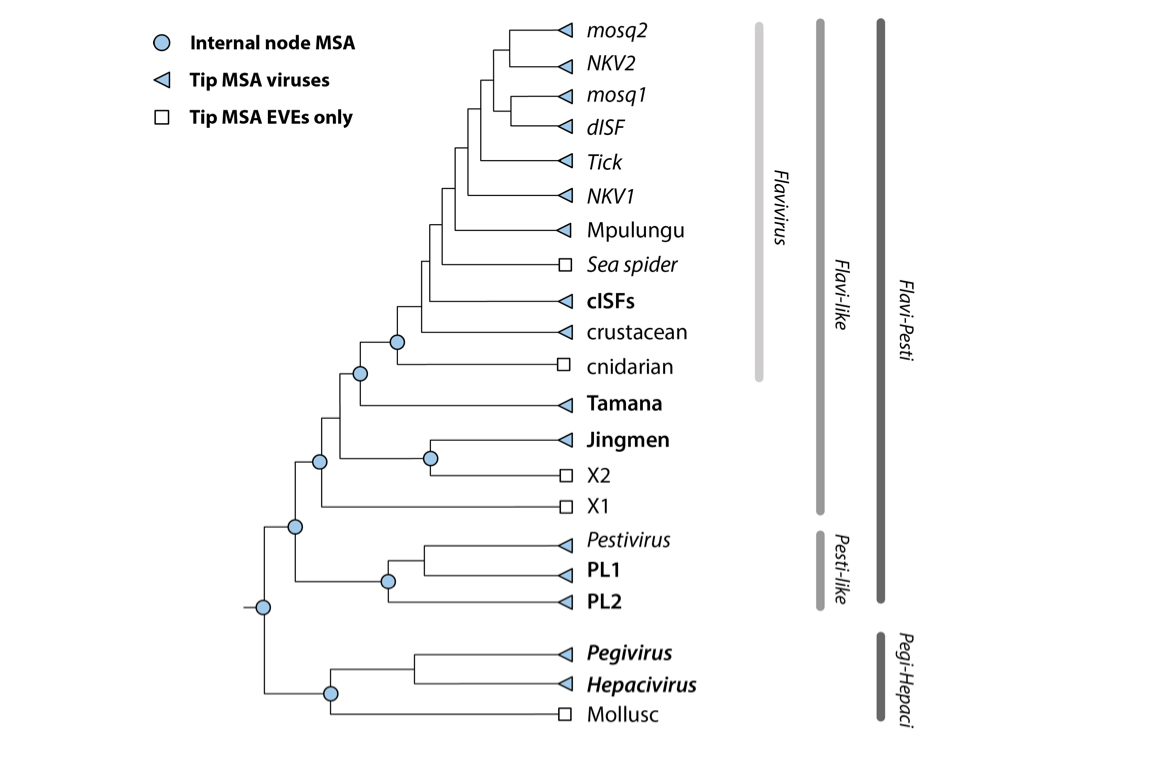-
Notifications
You must be signed in to change notification settings - Fork 0
Core Project Data
The Flavivirus-GLUE core project provides a minimal set of essential data components for performing comparative analysis.
The data items included in the core project are:
- A set of flavivirus genome feature definitions covering all genera.
- An annotated reference genome sequence for each flavivirus genus (i.e. one species per genus)
- A hierarchically arranged set of multiple sequence alignments representing sequence homology among flavivirus reference sequences.
We defined a standard set of genome features for flavivirids, reflecting current knowledge, and incorporated this information into Flavivirus-GLUE.
Currently, four flavivirid genera are recognised: Pegivirus, Pestivirus, Hepacivirus and Flavivirus.
These genera contain viruses that have monopartite genomes ~10 kilobases (Kb) in length and encoding one or more large polyproteins that are co- and post-translationally cleaved to generate mature virus proteins. The structural proteins of the virion - capsid (C), premembrane (prM) and envelope (E) - are encoded toward the 5’ end of the genome, while genes encoding non-structural (NS) proteins are located further downstream.

HCV Genome Features A schematic representation of the hepatitis C virus (HCV) genome. C=capsid; E=envelope; NS=non-structural; Kb=kilobases
A diverse variety of novel 'flavivirid-like' virus species have been described over recent years.
Most of these newly identified viruses have yet to be incorporated into official taxonomy.
They exhibit a much greater range of variation in genome structure than is found among representatives of officially recognised flavivirid genera, with genome sizes ranging up to 20Kb, and one novel group – the Jingmenviruses – comprises viruses with genomes that are segmented rather than monopartite.
The sequence data in this project are organised into multiple distinct sources.
Each source contains data in either GenBank XML or plain FASTA format.
The type of data is indicated by the name of the source (all GenBank XML sources contain 'ncbi' in the name).
GenBank XML files are imported into this project directly from NCBI GenBank using an appropriately configured version of GLUE's GenBank importer module.
The core Flavivirid-GLUE project contains a single NCBI-derived source - ncbi-refseqs - that contains 'master reference' genome sequences for each flavivirid species included in this project.
Where possible, we prefer to use sequences obtained via GenBank since it represents the principle source of published nucleotide sequence data.
However, FASTA sources can also be used in GLUE, making it straightforward to expand private instances of this GLUE project with unpublished sequences.
Genbank sequences are uniquely identified within GLUE projects by their GenBank accession numbers.
Sequences included in this project are linked to auxiliary data in tabular format.
We defined 'master' reference sequences to represent recognised flavivirid genera/subgenera, as follows:
- Mosquito-borne flavivirus group 2: Yellow fever virus 1 (NC_002031)
- Mosquito-borne flavivirus group 1: Dengue virus 1 (NC_001477)
- Tick-borne flaviviruses: Powassan virus (NC_003687)
- No-known vector group 1: Apoi virus (NC_003676)
- No-known vector group 2: Sokuluk virus (NC_026624)
- Dual-host insect-specific flavivirus group: Lammi virus (NC_024806)
- Mpulungu flavivirus group: Mpulungu flavivirus (LC582740)
- Classical insect-specific flavivirus group: Kamiti river virus (NC_005064)
- Crustacean flavivirus group: Crangon crangon flavivirus (MK473878)
- Tamanavirus: Tamana bat virus (NC_003996)
- Jingmenvirus: Jingmen tick virus segment 1 (NC_024113)
- Jingmenvirus: Jingmen tick virus segment 3 (NC_024114)
- Pestivirus: Bovine viral diarrhea virus 1 (NC_001461)
- Pesti-like 1 (PL2): Soybean cyst nematode virus 5 (NC_024077)
- Pesti-like 2 (PL2): Shuangao lacewing virus 2 (NC_028373)
- Hepacivirus: Hepatitis C virus (NC_004102)
- Pegivirus: Human pegivirus 2 (NC_027998)
We explicitly defined the locations of genome features on master reference sequences using GLUE commands (see here).
In GLUE, a 'constrained MSA' is an multiple sequence alignment (MSA) in which the coordinate space is defined by a selected reference sequence. Where alignment members contain insertions relative to the reference sequence, the inserted sequences are recorded and stored (i.e. sequence data is never deleted).
GLUE projects have the option of using a data structure called an alignment tree to link constrained MSAs representing different taxonomic levels, and we've used this approach in Flavivirus-GLUE.

The schematic figure above shows the 'alignment tree' data structure currently implemented in Flavivirus-GLUE. For the highest taxonomic levels (i.e. at the root) we aligned only the most conserved regions of the genome, whereas for the lower taxonomic levels (i.e. within and below genus level) we aligned complete coding sequences. We used an alignment tree data structure to link these alignments, via a set of common reference sequences. The root alignment contains reference sequences for major clades, whereas all children of the root inherit at least one reference from their immediate parent. Thus, all alignments are linked to one another via our chosen set of master reference sequences.
Alignments in the project include:
-
A ‘root’ alignment (i.e. family-level) constructed to represent homology between the two largest subgroupings in the Flaviviridae.
-
‘major-lineage’ alignments constructed to represent proposed homologies between representative members of major Flaviviridae lineages.
-
‘minor-lineage’ alignments constructed to represent proposed homologies between representative members of 'minor' Flaviviridae lineages.
-
‘genus-level’ alignments constructed to represent proposed homologies between the genomes of representative members of specific flavivirid genera.
-
‘subgenus-level’ alignments constructed to represent proposed homologies between the genomes of representative members of specific flavivirid subgenera.